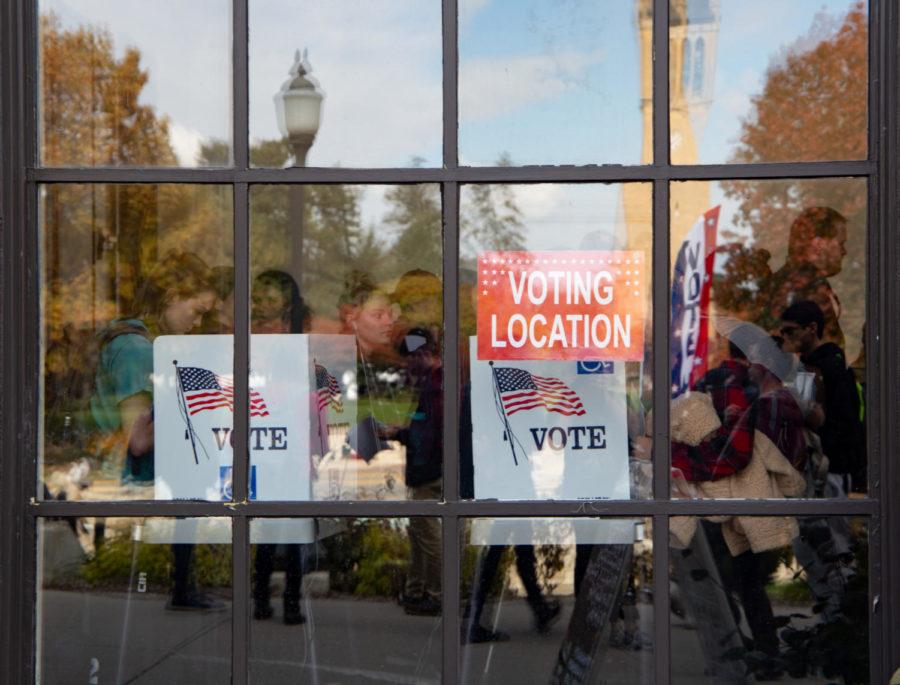Voting efforts in Story County throttle student turnout
Mikinna Kerns/Iowa State Daily
Voters line up on the 2nd floor of the Memorial Union Oct. 26.
November 5, 2018
Thousands of Iowa residents voted long before the polls opened at 7 a.m. on election day, capitalizing on alternatives to the standard Tuesday vote.
There were more than 13,500 votes received in Story county’s general election before Election Day compared to a total of about 447,500 votes which were received statewide.
These votes came primarily through absentee ballots and early voting locations. 1,873 of those were cast at the Memorial Union during the week of Oct. 22 to Oct. 26.
Story county auditor Lucy Martin said the turnout was much higher than previous midterm elections.
“Those numbers were more in line with the presidential turnout, but the student-heavy precincts typically turn out much lower than our other sites,” Martin said. “But nothing else indicates that in Story county. And again, I don’t know if the absentee turnout is actually a great predictor for election day turnout.”
According to Martin, many random events can have dampen citizens’ willingness to go to the polls, from storms to scheduling conflicts. Depending on the weather, she said, voter turnout rates could see a noticeable dip.
Various student organizations like Vote Everywhere and Iowa State’s student government made a concerted effort to increase the engagement of Ames’ college-aged residents, posting volunteers around heavily trafficked areas on campus to inform and help register potential voters.
“The main stuff that we do is to try to get students informed, and specifically provide the voter registration forms and stuff like that so students don’t have to find the right form online and print it off and send it in, all that kind of daunting stuff,” said Zoey Shipley, president of Vote Everywhere at Iowa State. “The big issue that we have is that incoming students, freshmen, don’t know that they can register at their current address here in Ames and still vote in Iowa or request an absentee ballot to vote back home.”
Shipley estimated that her organization had successfully registered at least 500 people, saying they’d registered over 300 people on national voter registration day. Based on what she has seen in the people that Vote Everywhere had registered in addition to turnout for early voting, Shipley said it seemed like college students were the more engaged in politics than in years prior.
According to voter registration totals from the Iowa Secretary of State’s office, Iowa Senate District 23, which encompasses Ames and its surrounding rural areas, had 38,860 active voters as of Aug. 1, 2018, when students often begin returning to Ames. As of Nov. 1, 2018, the most recent data available, the district’s active voter total had increased to 41,410.
Governmental officials across the state also worked to drive voter participation and educate voters on Iowa’s newly-implemented voter ID laws. Secretary of State Paul Pate said his office has focused on disseminating information through various interest groups.
“We have been using a multitude of approaches,” Pate said. “We’ve done everything from radio, TV, billboards, direct mail. We have over 100 organizations that have been a part of this process, and … we’ve given them the templates, if you will, to assist us in educating their base.”
As of Nov. 1, over 2.1 million voters were registered across Iowa, with nearly 70,000 of those living in Story county. About 157,000 registered voters statewide were marked as “inactive,” meaning that the state was unable to confirm their residence. The total number of registered voters dropped by just over one thousand since the 2016 presidential election — midterms, Martin said, are a time when registration numbers and participation rates typically drop.
However, 2018 does feature an irregularly high number of registered voters when compared to recent midterm elections. Both 2010 and 2014’s voter registration numbers dropped by over one percent when compared to their previous election years, while 2018’s total is only .05 percent under that of 2016. Martin said that the increase might be indicative of greater public interest in politics, but that increased activism might not translate to significantly higher voter turnout rates.
“The presidential election, that’s our highest turnout type of election where we see maybe 70% of our registered voters,” Martin said. “A typical turnout in Story county for a midterm election is about 50% of registered voters, and based on the absentees it looks like it’s going to resemble that, but I don’t know if absentees are the best predictor for what’s going to happen on Tuesday.”
As far as party affiliation goes, there are about 627 thousand registered Democrats and 650 thousand registered Republicans. For the first time in recent history, Libertarians are also represented on the ballot, with 13 thousand voters registered under the party. The group of voters affiliated without any affiliation was larger than any listed party at nearly 720,000.
Many voters in Iowa are registered as members of a political party due to the state’s closed primary system, which requires voters to declare their party affiliation in order to participate in that party’s primary election. Despite that, the party registration does not dictate a voter’s choices in the general election— voters are free to split their ticket, or even to vote for another party altogether.
Over 20 percent of registered Iowa voters have already cast a ballot in the 2018 election, leaving more than 1.72 million votes left to be cast at the time the polls open. Polls will remain open from 7 a.m. to 9 p.m. on Tuesday. In order to find your designated polling place, click here.
Emily Berch of the Iowa State Daily contributed to this article.







